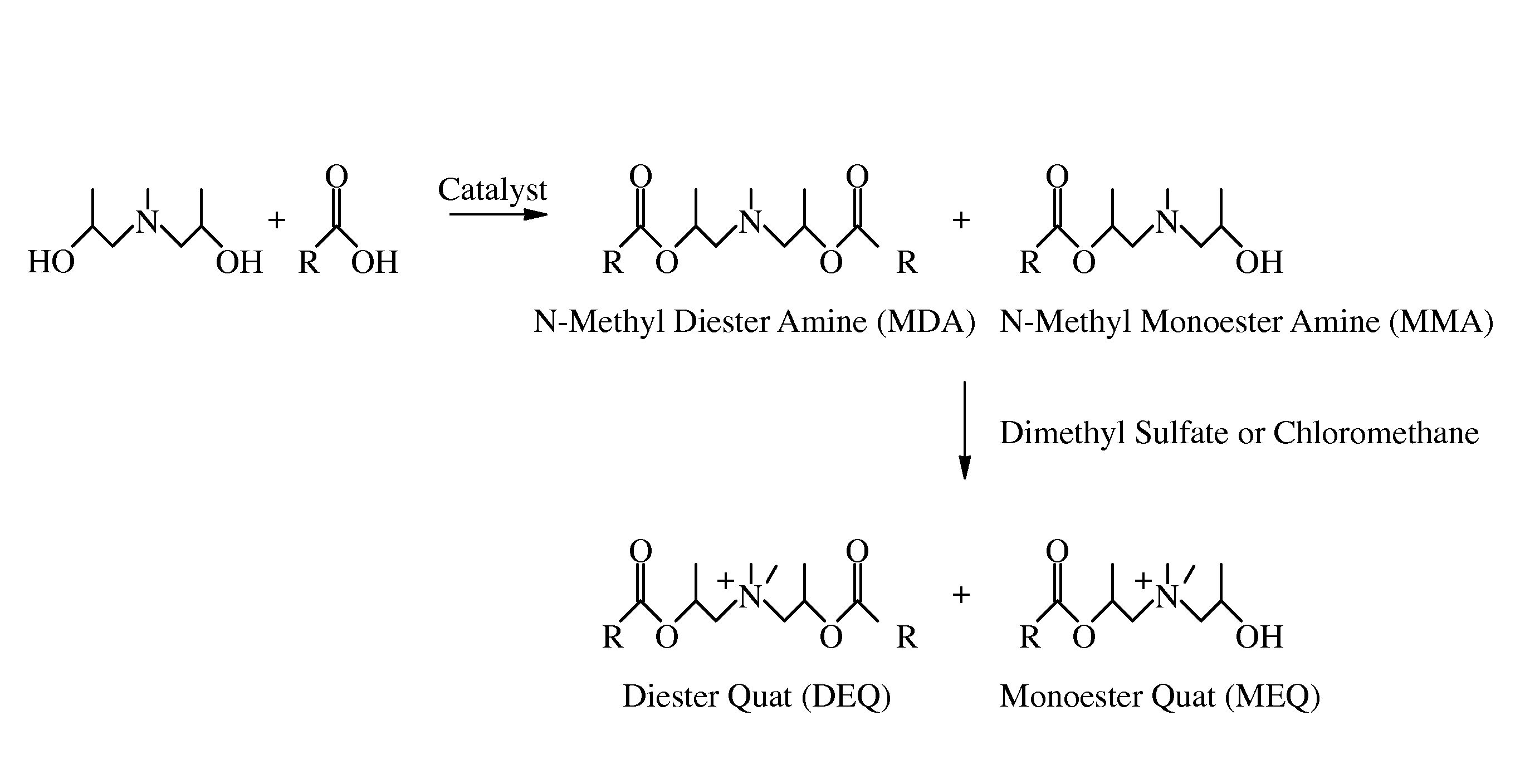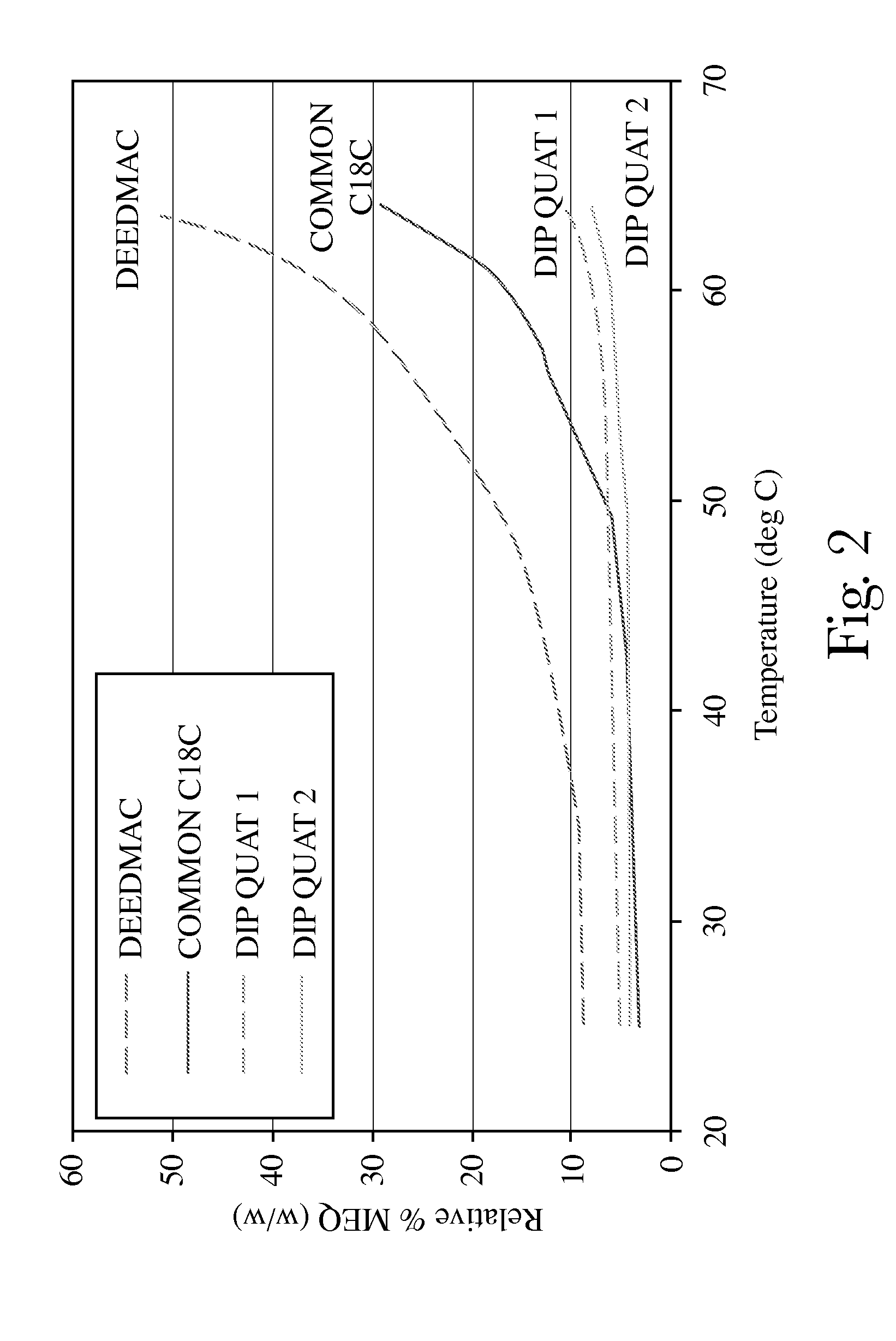Heat Stable Fabric Softener
a fabric softener and heat stable technology, applied in the field of fabric softeners, can solve the problems of heat stability, heat stability, and exacerbated problems, and achieve the effects of reducing the number of occurrences of occurrences, reducing the number of occurrences, and improving the quality of occurren
- Summary
- Abstract
- Description
- Claims
- Application Information
AI Technical Summary
Benefits of technology
Problems solved by technology
Method used
Image
Examples
example i
[0067]2168.4 g (7.94 mol) of partially hydrogenated tallow fatty acid with an IV 20 is placed in an electrically heated reactor equipped with a thermometer, a mechanical stirrer and a rectifying column and is esterified with 596 g (4.083 mol) bis-(2-hydroxypropyl)-methylamine by heating with stifling to 200° C. and is kept at this temperature for 4 h at ambient pressure, distilling off water through the rectifying column. The pressure is then reduced to 10 mbar and the mixture is further stirred for 7 h at 200° C., and water is removed with a vacuum pump until the acid value of the reaction mixture is 5.6 mg KOH / g. The resulting mixture is then cooled to 75° C., 106 g of coconut oil is charged and 489 g (3.87 mol) dimethylsulphate is added and the resulting mixture is stirred for 2 h at 75° C. 318 g of isopropyl alcohol is added and the reaction mixture homogenized. The resulting fabric softener active composition is a white solid, containing 0.066 mmol / g (1.8% by weight) fatty acid...
examples
[0076]The following are non-limiting examples of the fabric care compositions of the present invention.
FORMULATION EXAMPLES(% wt)VIVIIVIIIIXXXIXIIXIIIXIVFSA15a 12.25b12.25b12.25c12.25d5d 5a 17e 12.25eIsopropyl1.531.251.25—1.250.5 0.5 ——AlcoholEthanol———————1.75—Coconut Oil0.510.420.42—0.170.170.58—Starchf———————0.8 —Thickening0.150.010.15——0.010.01——AgentgPerfume0.5 4.02.44.03.51.5 0.5 1.254.0Perfume————0.25——0.5 —Micro-capsuleshCalcium0.100.05—0.100.10——0.190.10ChlorideDTPAi0.050.050.050.050.050.050.05 0.0080.05Preservative75 7575757575 75 75 75(ppm)jAntifoamk 0.0050.0050.0050.0050.005 0.005 0.005 0.0140.005Dye (ppm)40 6575656550 50 30 65HCl 0.0200.0100.0100.020.020.010.02 0.0100.02Formic 0.0250.0250.0250.0250.025———0.025AcidDeionizedBalanceBalanceBalanceBalanceBalanceBalanceBalanceBalanceBalanceWateraFabric Softening Active from the reaction product of Example I.bFabric Softening Active from the reaction product of Example II.cFabric Softening Active from the reactio...
example xv
Through the Rinse Performance of Example VI and XII Compared to DEEDMAMS
[0077]Representative fabrics (100% cotton EuroTouch terry towels obtained from Standard Textile, 2250 Progress Dr., Hebron, Ky.) are washed using a Kenmore 80 series, medium fill, 17 gallon, top-loading washing machine using Ace powdered detergent on the heavy duty cycle (90° F. Wash / 60° F. Rinse). The liquid fabric softener control that is made using 5% DEEDMAMS and the fabric softener made from Example VI and XII and are added into the final rinse cycle. The amount of fabric softener added to the washer is normalized to deliver an equivalent amount of fabric softening active to the washing machine. Fabrics are dried using a Kenmore series dryer on the cotton / high setting for 50 min. The treated fabrics are compared and the difference in softness relative to a no treatment in the rinse control is judged by expert graders. Results are expressed using the standard Panel Score Unit scale: +4 psu (very large differ...
PUM
 Login to View More
Login to View More Abstract
Description
Claims
Application Information
 Login to View More
Login to View More - R&D
- Intellectual Property
- Life Sciences
- Materials
- Tech Scout
- Unparalleled Data Quality
- Higher Quality Content
- 60% Fewer Hallucinations
Browse by: Latest US Patents, China's latest patents, Technical Efficacy Thesaurus, Application Domain, Technology Topic, Popular Technical Reports.
© 2025 PatSnap. All rights reserved.Legal|Privacy policy|Modern Slavery Act Transparency Statement|Sitemap|About US| Contact US: help@patsnap.com



